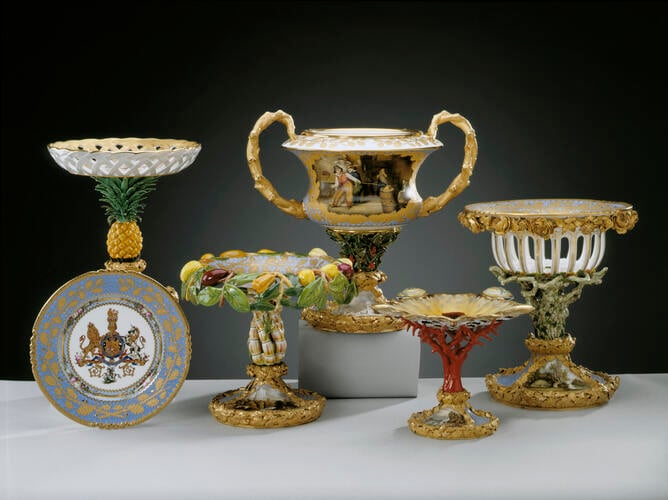-
1 of 253523 objects
A dessert service, known as the Coronation Service 1800-37
Bone china | RCIN 5000040

Rockingham Works [Yorkshire] (c. 1745-1842)
A dessert service, known as the Coronation Service 1800-37
-
This service, originally consisting of fifty-six large pieces and twelve dozen plates, may claim to be the most ambitious ever produced by an English factory. The Rockingham Works was established in 1825 at Swinton in Yorkshire under the patronage of the second Earl Fitzwilliam (nephew and heir of the Marquis of Rockingham) by the brothers Thomas, George Frederick and John Wager Brameld. By far the youngest of the factories from which services were ordered by William IV following his accession in 1830, the Rockingham Works quickly established a reputation for producing wares of outstanding quality.
Designs for the service were in hand during the autumn of 1830, and samples were sent to William IV for approval: a plate resembling the final pattern, but with an orange ground to the rim instead of the chosen 'Brunswick' blue, is one such sample. As with the Davenport and Worcester services, national symbols formed part of the decorative imagery: the centres of the plates were painted with the royal arms, and the national flowers occupy those of some of the comports; while raised and gilded roses, thistles and shamrocks, as well as oak leaves and acorns, are entwined and encrusted around the painted reserves of the shaped pieces. (According to the York Courant for 13 July 1837, the inclusion of oak leaves was at the King's own suggestion.) But in addition, the Rockingham service evoked Britain's maritime achievements and foreign dominions. In the 760 painted reserves there are Indian and Caribbean scenes as well as British landscapes, castles and country houses; and the wonderfully modelled pineapples, sugar-cane stems, exotic fruits, corals and shells also evoke Britain's more distant possessions. The designs were made by John Wager Brameld. All of the artists responsible came from within the Rockingham factory's own workforce of around six hundred. They included the modeller Thomas Griffin and the painters George Speight (royal arms), Thomas Brentnall (flowers), William Willis Bayley, William Corden and (probably) Henry Pedley. The factory's chief gilder was Isaac Baguley.
The 'ice-cellars' or pails and the small vases forming finials to the 'triple dress plates' are variations on the antique Warwick Vase discovered in Rome in 1770 (Glasgow, Burrell Collection), decorated with scenes after Reynolds, Teniers, Wilkie and William Collins.
The tiered 'triple dress plates' (of which eight were made) were intended for almond pastry. Four 'double dress plates' with only two tiers were also supplied, as well as eight 'grand baskets' for fruit. The smaller 'shell comports' modelled as limpets with clinging mussels and samphire, supported on red coral and mostly decorated with maritime scenes around the feet, were intended for preserves. The eight 'tropical' comports with sugar-cane supports are surrounded by a wreath of East and West Indian fruits which are identified by inscriptions under each as mango, white guava, malay apple, mangotan, mammee, akee, alligator pear, custard apple and longan. These were probably derived from the plates in F.R. de Tussac's Flores des Antilles (Paris, 1808-27) and M.E. Descourtilz's Flore pittoresque et medicale des Antilles (Paris, 1821-9). The reserves on the foot of the tropical comport are painted with Matlock High Tor Derbyshire and Downe Castle.
The service was not completed until 1837, when it was placed on show at the Bramelds' London showroom in Tichborne Street. It was still on display there at the time of the King's death in June, and remained unused until Queen Victoria's coronation the following year. Despite widespread contemporary praise for the service, its protracted manufacture brought about the Bramelds' ruin. As Jewitt remarked in his monumental Ceramic Art of Great Britain, the brothers 'looked to Art instead of commerce, and the result was embarrassment and loss'.Provenance
A dinner service, known as the Coronation Service, commissioned by William IV in 1830 at a cost of £5,000, completed in 1837 and first used at Queen Victoria's coronation banquet, 1838.
-
Creator(s)
(porcelain manufacturer)Acquirer(s)
-
Medium and techniques
Bone china
Category